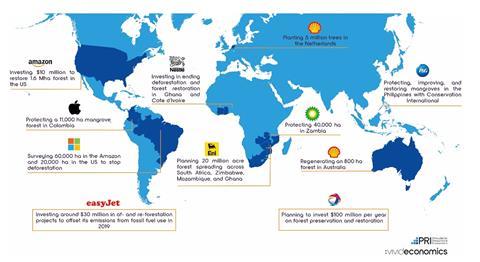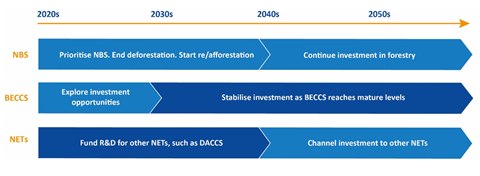
As momentum towards net zero rises around the world, this report provides much needed transparency on the importance of land use and the role of Negative Emissions Technologies (NETs) in the transition.
The report analyses the growth in corporate climate commitments and probes some of the key assumptions in major climate scenarios to uncover opportunities for investors – particularly in forest related nature-based solutions – while also highlighting the risks and uncertainties associated with some negative emissions technologies. It finds:
- Negative Emission Technologies (NETs) are the next investment frontier and offer trillion-dollar upside opportunities for investors.
- Within NETs, Nature-based solutions (NBS) to the climate crisis focused on reforestation and afforestation are the most viable near term opportunity and could generate US$800 billion in annual revenues by 2050 with assets valued well over US$1.2 trillion, surpassing the current market capitalisation of the oil & gas majors.
- Investments in avoided deforestation will present additional opportunity as measuring, reporting and verification (MRV) mechanisms and compensation schemes reach scale. However, reputational risks may dampen investor enthusiasm unless forest laws are vigorously enforced or tightened to end deforestation.
- Technical solutions, such as Direct Air Carbon Capture, Use and Storage (DACCS) and bioenergy with CCS (BECCS), are ones to watch longer term and could generate an additional annual revenue of US$625 billion by 2050.
An ‘inevitable’ part of achieving Paris
The report shows that alongside deep decarbonisation, all climate scenarios rely on so-called negative emissions technologies (NETs). In 2018, the International Panel on Climate Change (IPCC) set out four representative pathways that align to a global temperature rise of 1.5oC. Alongside deep decarbonisation, all rely on negative emission technologies.
- Even the most ambitious in decarbonization terms, P1, relies on carbon removal to sequester 2.5 GtCO2/year in 2050.
- In the IPCC’s ‘slower’ P4 scenario, total negative emissions are 16 GtCO2 in 2050, roughly around half of CO2 emissions from combustion of fossil fuels today. The reliance of the climate scenarios on NETs increases further in the second half of the century.
Beyond the models – corporate commitments are driving demand
In less than a year, there has been a three-fold increase in the number of companies committed to net zero, from 500 recorded in 2019 to 1,541 in 2020. The pace of ambition is particularly marked among the highest emitting sectors and those worst hit by the pandemic – in oil & gas, steel, cement, automobile, and food.

To fulfil these commitments, companies will require deep decarbonization efforts, with residual emissions balanced by investment in carbon removal activities. This has driven demand for natural and technological solutions that actively suck carbon from the atmosphere, which in turn is driving the demand for nature-based carbon credits. From 2017 to 2018, the value of forestry and land-use-related credits traded in the voluntary offset market tripled to US$172 million, increasing the share of forestry and land-use-related offsets in the total voluntary offset market by 23%, from 52% to 64%.
Many companies have already started to channel their resources into forest related natured based solutions to help achieve new net-zero targets (Figure 1).
Win-win: profiting from an end to deforestation
While many corporate commitments are focusing on reforestation, stopping deforestation is critical to climate action and could also present a large investable opportunity – comparable to afforestation and reforestation – if markets can be developed and commercialised. Yet, data suggests deforestation has doubled during the pandemic.
As well as constraining a large investible market, companies with deforestation in their supply chain expose investors to significant financial risk in terms of potential regulatory action, loss of market access, loss of customers in the short term, and failing to adapt to the transition to a low-carbon economy in the longer term (Ceres, 2020). Analysis from the Inevitable Policy Response project suggest that risks associated with legal action, market access, and consumer pressure could decrease a company’s valuation by around 15%.
Bioenergy: unrealistic and dangerous assumptions
Bioenergy with carbon capture and storage (BECCS) is the leading negative emission technology in all Paris-aligned scenarios, because of its double gains through energy generation and CO2 sequestration. But producing high levels of bioenergy to the degree assumed necessary is likely to push the world to its planetary boundaries in terms of water and land availability. In some of the less ambitious pathways to Paris (IPCC P4), negative emissions by BECCS exceed 16 GtCO2/year by mid-century. Yet this is over three times the estimated sustainable scale, when other land use requirements such as food are taken in to consideration.
To limit such negative side effects, most studies suggest that BECCS needs to be limited to a sustainable scale, around 0.5 – 5 GtCO2/year (2). To avoid these blind spots, the report provides decision makers with the transparency they need on the use of negative emissions technologies in net zero pathways, as well as a realistic scenario that fully integrates land use systems.
Investors can proactively shape the market to unlock opportunities
Investors who move early have a unique opportunity to support the forestry market’s institutional development by engaging with policymakers and companies while developing innovative business models and financing mechanisms to channel finance:
- Pressure companies to commit to climate action, invest in NBS and ensure deforestation free supply chains.
- Stop investing in companies with deforestation in their supply chain.
- Move early in the rapidly growing NBS market
- Support NBS market and institutional development by engaging with policymakers.
- Promote a global standard for NBS projects.
- Promote sustainability standards for BECCS.
- Monitor developments in the DACCS space.

Downloads
An investor guide to NETs and the importance of land use
PDF, Size 2.29 mb











